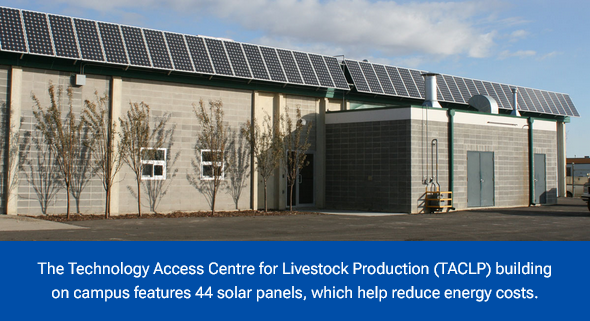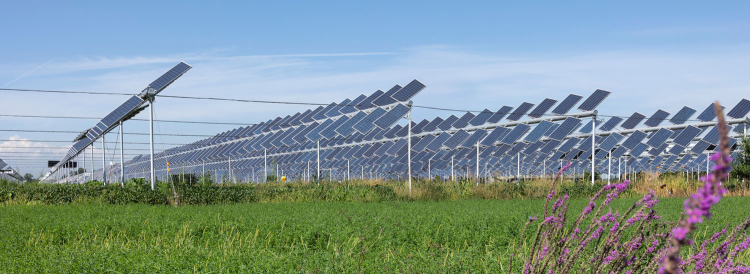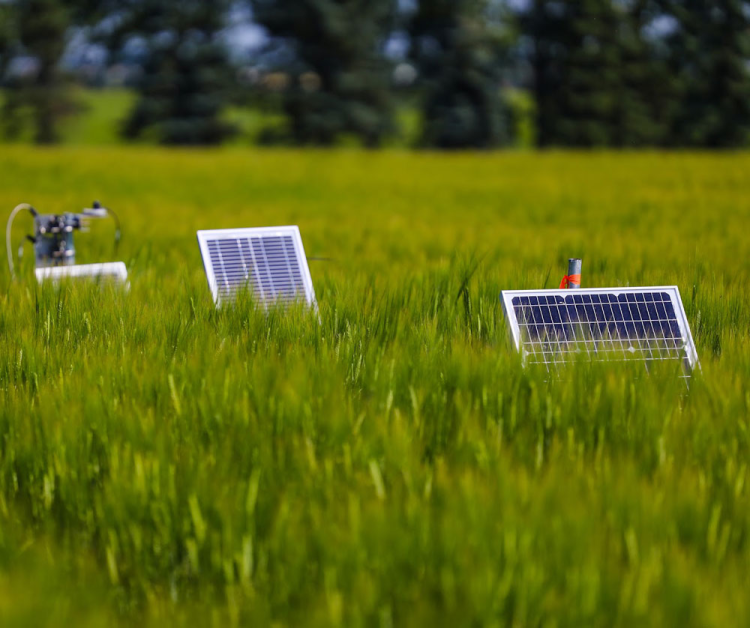Olds College of Agriculture & Technology wants to become a national leader in research detailing how Canadian agriculture could be revolutionized by farmers and solar energy projects sharing the same land.
"If we're successful, this will be the first agrivoltaics research program of its kind in Canada, and it will be a massive program," said Ike Edeogu, who is the Manager, Crops and Environmental Stewardship applied research programs at Olds College Centre for Innovation (OCCI).
The world's soaring population, and fears about climate change, are placing rival pressures on farmland for both food production and the generation of zero-carbon electricity. Agrivoltaics is an emerging sector that seeks to replace this competition with mutually beneficial co-operation.
"I think there's a window for us to actually support and potentially enhance farming," said Dr. Steven Tannas, president of Tannas Conservation Services of Cremona, Alta. "There are numerous forms of agricultural production, and if you design a solar project properly and choose the right agricultural production system, you could increase the agricultural productivity of the land while maximizing the electricity generation."
It could allow farmers and solar facility owners to earn additional income that could help boost rural economies, said Edeogu. "It could also help conserve the land and increase land use efficiency."
A boom in industrial-scale solar and wind projects in Alberta sparked a backlash among farmers and rural residents. The provincial government decided in 2024 that such projects can no longer proceed on prime Class 1 and Class 2 farmland unless they prove they can co-exist with crops and/or livestock.

OCCI is in the initial stages of planning and proposing to Olds College leadership what it hopes will be a multi-year research program. Edeogu said the goal will be to provide reliable scientific data so that farmers, rural leaders, the solar industry/agrivoltaics sector, and government policymakers and regulators can make informed decisions.
It will include examining the potential impact of the installation of solar projects on wildlife, such as pollinators and natural habitats. This is an aspect of what is known as ecovoltaics - an agrivoltaics model that aims to restore biodiversity, pollinator habitats and wildlife alongside solar power generation.
Join us for a one-day conference on Advancing Agrivoltaics for Alberta's Sustainable Future
As Olds College develops its research program, it will also be hosting a conference called Advancing Agrivoltaics for Alberta's Sustainable Future. The one-day event on June 26 is being organized by Agrivoltaics Canada and it will explore the latest trends, technologies and policies as presented by industry experts.
Agrivoltaics isn't about simply trying to fit together conventional agriculture with typical practices in solar power generation, said Edeogu. "We're saying agrivoltaics is its own sector, and it's an emerging economic sector. Let's look at it that way and see how we can develop it."
Pending partnership, collaboration and approval, OCCI aspires to initiate some experiments this year at the Olds College Smart Farm. Campus officials are also in discussions with several renewable energy companies about conducting research at solar projects in Alberta, as well as potentially launching studies on farms.
Other initiatives include a survey examining the acceptance of solar projects by Alberta farmers, said Dr. Semeton Amosu, who is a Research Associate and Soil Scientist with the Environmental Stewardship Applied Research department at OCCI.
"There's been a lot of skepticism and resistance about farmland being used for solar. And are they aware of agrivoltaics, which is the possibility of practicing agriculture within the panels?"

A report reviewing the current state of agrivoltaics in Alberta is also being planned, he said. "Probably by the third quarter of this year, it will be fully ready, and then it will be out there as well."Tannas is collaborating with Olds College to develop its research program, which he said could include studying the impact of solar projects on microclimates and soil health. Solar panels could help farmers optimize production by regulating temperatures during heat waves and acting like shades, or even solar fences, he said.
The panels could protect crops from wind damage and trap snow to boost soil moisture and crop yields, he said. "You could even use the panels to capture rainwater and direct it to storage using irrigation lines that could run the water to where you need it."
Different crops and livestock could be raised to determine the best fit for agrivoltaics in the Canadian prairies, said Tannas. They could range from specialty crops such as berries to market garden and leafy vegetables, along with pulse and forage crops such as legumes, perennial grass and hay, he said.
Amosu said livestock research will likely include raising sheep using rotational grazing. Tannas said the typical practice in Alberta of simply using sheep to control grass and weeds under solar panels is not really agricultural production.
"Agrivoltaics is where we actually design the vegetation and forage to maximize productivity and create viable farming practices within a solar project. Grazing sheep is a component of it, but it could range from cattle, goats and chickens to pig production, which all depends on the location for each production system."
The research program will likely be divided into testing of up to six different models of agrivoltaic development, said Amosu. He expected they will include field crops such as canola, faba beans and wheat grown in rotation.
Profitability and the net present value of agrivoltaic development will also be determined and reported so that farmers, the solar industry and other investors have a clearer idea of what to expect.

Tannas said the ability to raise field crops within solar facilities has been hindered by designs that lack space for conventional farm equipment. "We are looking at production within the panels and trying to find ways to mechanize that."
Olds College is currently in talks to partner with a company to deploy autonomous weeding and seeding equipment for agrivoltaics. Researchers outside the College are already testing automated solar panels that use computer algorithms to track and maximize the sunlight required by different crops.
Other initiatives could eventually include installing and testing special translucent solar panels in the College's greenhouses that generate electricity while letting through adequate light to grow plants, said Edeogu.
"There is also the possibility of using solar panels as fences in feedlot pens, among several other applications. We're very much interested in it, but there's so much of a knowledge gap right now about this technology that it's likely going to be a project for the future."









